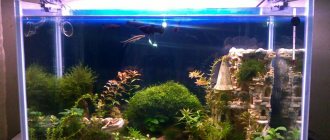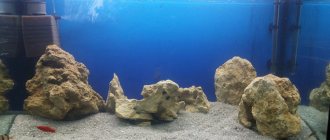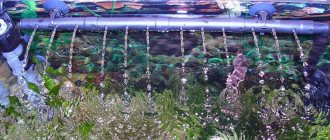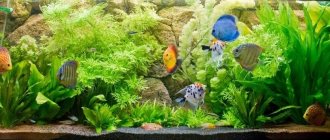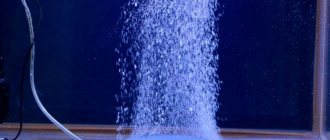Such a bright and unusual decorative element as an aquarium decorates interiors, bringing aesthetic pleasure from observing the life of its inhabitants. But it is necessary to realize that, despite its decorative purpose, an aquarium is part of the natural world, a copy of a real reservoir, including the natural processes occurring in it. That’s why every element of the aquarium, in particular the soil, is so important.
It is thanks to a well-chosen type of substrate that aquarium plants take root and grow, the health of which in turn determines the condition of underwater inhabitants. The quality and composition of the soil affects the habitat of the fish, and also shapes the appearance of the aquarium. In addition, the soil plays a biological role, being a reservoir of beneficial bacteria that purify water from naturally occurring toxic substances. These bacteria are capable of neutralizing toxins that appear as a result of the life processes of organisms in the reservoir; they are an integral part of the aquarium ecosystem, which is why it is so important to choose a suitable soil.
Rating of the best soils for an aquarium
| Nomination | place | Name of product | price |
| The best soils for an aquarium with a lot of plants | 1 | Power Sand Special M (ADA) | 4 480 ₽ |
| 2 | DeponitMix (Dennerle) | 1 520 ₽ | |
| 3 | JBL Manado | 1 950 ₽ | |
| The best soil mixtures for standard aquariums | 1 | UDeco “White gravel”, natural, 3-5 mm, 2 l | 296 ₽ |
| 2 | Aquarium soil Barbus “Mix” | 56 ₽ | |
| 3 | Aquarium soil "EKOgrunt", marble chips | 139 ₽ |
How to choose soil for an aquarium?
Sand
Some species of fish live only in sand; they use quartz sand to improve digestion, like to burrow into the depths or spawn. Sand is good because it brings the aquarium environment closer to the natural one. The roots of plants firmly cling to the sand, creating a fertile environment. No dirt gets into the substrate and it is easy to clean. Sand can be quartz, river, white aragonite, sea, live and black.
sand
Pebbles
River or sea pebbles are beautiful and natural, often used to decorate aquariums. The size of the fractions may vary. Black pebbles are in demand today, but they can reduce water quality and inhibit the growth of valuable microorganisms. Small sea pebbles are a natural material. The pebbles are baked in the oven before use.
pebbles
Basalt
Modern aquarium hobby considers the most popular neutral soils to be river pebbles, coarse sand, quartz and basalt chips. The listed substances, including basalt, do not nourish plants. Basalt contains iron and is magnetic. If you have a planted aquarium and the bottom has neutral soil, then add fertilizer.
basalt
Nutrient soil
Nutritious soil is sometimes not a necessary condition, although it purifies the water well. With the help of nutrient mixtures you can easily grow a large number of plants in an aquarium. In such conditions, beneficial bacteria multiply quickly. Supplement your nano or Canadian aquarium with nutritious soil, and you will not regret it. The composition contains bacteria, porous material, mineral fertilizers and peat.
nutrient soil
Black soil
Black primer is a decorative natural material that is in demand among aquarium enthusiasts. For example, shungite, basalt and granite are popular. The negative side of black soil is the gray, non-aesthetic appearance of the aquatic environment. Pomegranate has magnetic properties, but this is dangerous for fish and plants. The best option for black soil is quartz, which does not pollute the water.
black primer
White soil
The white color is easily soiled and turns into light brown and possibly greenish. It is known that some medications for treating fish contain synthetic dyes - green, malachite, blue, methylene. White soil may take on one of these undesirable colors. When white soil is taken from the natural environment, it is most likely limestone or marble. The substances are soluble in water with the help of organic acids, which makes the water harder. Not all species can live in such hard water.
white soil
Quartz soil
Plants take root in quartz chips, and it absorbs the remains of fish life. This is a prime example of neutral ground. Quartz sand allows you to beautifully decorate your aquarium. The material is sold untreated.
quartz soil
Colored primer
Natural soils, such as polished and crushed rocks, sand, and gravel, once constituted the natural substrate of reservoirs. To decorate sand, it is painted in different colors. If your tropical fish live in fresh water, then choose dark tones of the soil, as they bring the environment closer to natural. If you overuse bright and light colors, there is a high probability of accidentally coloring the fish (fish tarnishing).
colored primer
Marine soil
A saltwater aquarium is always filled with very fine sand. Its color is white, sometimes pinkish, less often black. If you make a blue, black, dark background, decorate with natural stones, then the aquarium will create a picture in the form of a reef at the bottom of the sea.
sea soil
River soil
One type of sand for an aquarium is river soil. It has been known as a filler for many years. Some believe that this product is dangerous, but according to aquarists, this is one of the best varieties of soil. You can buy sand or collect it from nature yourself and pass it through a double sieve.
river soil
Decorative artificial soil
Today, artificial soil is made from polymer material, glass and plastic. The main task of the finished substance is to decorate the aquarium. You can make sand shine, make it flexible, give it a chameleon effect.
decorative soil
Coarse soil
The average size of soil at the bottom of the aquarium is 3-5 mm, it breathes optimally. If we are talking about a size from 7 mm, this is already considered a large size. The negative side of coarse soil is that particles of fish food are lost in it, it is impossible to get it, since it is difficult for fish to move large pebbles. And in these pieces, rotting processes develop and planaria worms appear in large numbers.
coarse soil
Shallow soil
Most manufacturers offer sand with fractions from 2 to 7 mm. Fine soil is good for setting up a freshwater aquarium. The natural soil is represented by fine real quartz. Aquatic plants take root in the soil. As a rule, fine soil is harmless to plants and fish; it is washed before use.
fine soil
How much soil should I put?
How thick should the layer of aquarium gravel be - this question has been very often and hotly discussed in all aquarium forums in recent years.
Previously it was believed that the larger the soil layer, the better for the growth of beneficial bacteria and more space for the roots of plants with a massive root system. But recently, many aquarists have pointed out that deep layers of gravel, especially sand, harbor debris, and the deep layer encourages the growth of anaerobic bacteria, which can lead to the formation of hydrogen sulfide gas pockets that inhibit plant root growth. Also, if old waste from deep layers of soil gets into the water, it can lead to spikes in ammonia, nitrites and nitrates. Therefore, although many advise periodically stirring the soil to avoid the appearance of hydrogen sulfide pockets, “opening” one of them can greatly harm the living population.
In fact, the picture is not so terrible. There are examples when, in an aquarium with a gravel layer of more than 20 cm, plant roots reached the very bottom, accumulating there, and aquarium fish lived in such an aquarium for seven or more years.
A layer of nutrient soil in the aquarium up to 10 cm
In general, we can say that a soil layer of up to 10 cm is quite normal, it all depends on the plants chosen. On average, a soil layer of 5-7 cm or more is recommended for large plants with a strong root system.
- Soil calculator
It is not necessary to strictly follow someone’s advice when laying out the soil according to the books: a higher layer at the back wall, a smaller layer at the front. Create your own design, use multiple layers of gravel, place different colors of different layers in different areas. Create and enjoy your creation!
Barbus "Mix"
If you are concerned about finding bottom material for rooting plants in your aquarium
for not-so-small freshwater fish, then such a proposal will find a response in their hearts. The ideal option is provided by 5-10 mm white and black particles, which resemble natural coarse sand deposits. This is a real stone chip, neutral in chemical composition. It is simply loved by those inhabitants of the world under water, whose nature is to constantly excavate the soil. To avoid cloudiness of the water, a small substrate is not suitable for them. And being deprived of their pleasure means causing depression. The 3.5 kg package is designed for 20 liters, and it is recommended to wash the material in advance.
How to prepare the soil?
Preparing the soil for an aquarium includes thorough cleaning and disinfection - sifting through a coarse sieve, rinsing with running water followed by boiling, and also checking for the presence of calcium carbonate in the soil. To carry out the test, it is necessary to spill the soil with ordinary table vinegar. If a hissing foam forms on the surface of the soil, then the soil contains calcium carbonate impurities and is only suitable for placement in an aquarium for fish living in water of high hardness.
UDeco River Amber "Amber gravel"
Leader in consumer demand Country: Russia Average price: 300 rub. Rating (2019): 4.7
The “Amber Sand” line is represented by a wide range of sizes of fractions included in the packages – from 0.1 mm to 5 mm. Our review includes the most popular variety, which includes particles from 2 to 5 mm. The rounded material does not change the overall and carbonate hardness, so it is appropriate to use it in universal structures. It is characterized by a natural sand color and light transparency. Both plants and fauna feel equally comfortable in it, especially if volcanic lava of the same brand is additionally used as a substrate. “Amber gravel” can also be laid in paludariums or terrariums.
Black
Taking into account the decorative function of the substrate, the aquarium is designed to emphasize the beauty of the aquatic “garden” and the fish living in it. As practice shows, black in the “home” for fish looks very advantageous, since due to its color, contrasting fish look very bright. Any dirt will be more visible on a white background than on a black or dark gray background. Black aquarium soil can be natural (black quartz, granite chips) or painted (almost any type, but you need to choose those brands whose product does not fade).
When choosing black flooring, pay attention to German-made products:
- Dennerle Crystal Quartz.
- Price in Moscow is 979-1260 rubles per 4.92 kg.
- The filler is black, the granules are well rounded, safe for representatives of the aquatic world. The flooring is perfect for good vegetation development. Fraction 0.7-1.2 mm. Bottom flooring for nano-aquariums. Manufacturer – Germany.
- Pros:
- CO2 resistance;
- Rounded particles;
- Natural color;
- Neutral to water, does not change hardness;
- Promotes the development of the root system of plants.
- Cons: none found.
Cheaper options:
- Hydor H2SHOW.
- Price 432 rub. for 5 kg.
- High-quality painting, natural quartz. Well rounded, safe and convenient for the inhabitants of the home pond. Designed to be used together with other decorations in the Water World concept, but can also be safely used separately.
- Pros:
- Does not emit harmful substances, does not shed;
- Neutral, suitable for all bodies of water.
- Cons: none found.
Rating of the best soils and soil mixtures for aquariums
The best neutral soils for an aquarium
Chemically neutral soil is a soil of natural origin that does not contain nutrients. These are gravel, pebbles, small stones, volcanic sand. Neutral soil does not contribute to the rapid growth of plants: until the required amount of nutrients accumulates in the soil, formed during the decomposition of waste products of organisms (silting). This takes about six months.
In addition to neutral, natural soil that has been processed, for example, expanded clay or specially treated clay, is suitable for a standard aquarium.
In both cases, for better plant growth, it is necessary to purchase additional fertilizers.
Sand and gravel
This soil option is the most budget-friendly and simplest. At the same time, this is the most popular and optimal mixture, suitable for most species of plants and fish, as well as unpretentious inhabitants of the aquarium. Sand combined with gravel provides the best substrate for beneficial bacteria. The particle size in the mixture is approximately the same (gravel - 5 mm, sand - 2 mm), which contributes to less caking of the soil. As for gravel, it is better to choose rolled pebbles - they will not injure the fish, unlike sharp particles.
This type of soil performs its biological function well, but the nutrients necessary for vigorous plant growth appear in it as it silts, which usually occurs within several months. The average cost of the mixture (for 1 bag weighing 6 kg) is 300 rubles.
Advantages:
- ensures excellent water circulation in the aquarium;
- copes well with its biological function;
- neutral and does not affect the chemical composition of water;
- cleaning and cleaning the aquarium is simple and comfortable;
- natural and natural appearance;
- inexpensive.
Flaws:
- the lack of nutrients in the soil makes it necessary to purchase additional fertilizers for plant growth;
- Not applicable to fish species that burrow into the ground, such as freshwater stingrays.
Treated natural primer JBL Manado
The baked clay soil not only gives the aquarium a natural appearance, but also ensures safety for bottom inhabitants due to its streamlined surface, which prevents injury to the fish. This is the most neutral and natural type of soil. Its porous structure is perfect for the formation and reproduction of beneficial bacteria that promote plant growth and health. In addition, baked clay - expanded clay - is a natural absorbent, which means it acts as a natural filter for water, purifying it from excess waste and excess fertilizers. This prevents the occurrence and proliferation of algae. In addition, expanded clay does not cake. The average cost for 1 package weighing 5 kg is 850 rubles.
Model name
Appearance - which color to choose?
Multi-colored gravel will make the aquarium very fun to look at, but will also draw attention away from the fish and decorations. If you do decide to use brightly colored soil, make sure that it will not harm living creatures.
Aquariums with live plants and a minimum number of fish are now very popular. If you are determined to get into aquatic design with live plants, pay attention to choosing soil that will help them grow.
Many fish and shrimp show their best colors thanks to a dark-colored substrate, while other transparent, colorless and neon fish begin to shine against the background of a dark bottom and living plants. In addition, dark colors have a more calming effect on fish, and calm fish also appear brighter. Ultimately, dark gravel looks the most natural in an aquarium and is often the best choice.
White gravel in an aquarium
In recent years, white gravel and sand have also become very popular, and in combination with living plants, the white substrate looks very impressive, but those who use it often complain that any debris is very clearly visible on white sand and it doesn’t look very good over time aesthetically pleasing.
What to look for when choosing soil for an aquarium
First of all, determine what kind of fish you will place in the aquarium and whether there will be live plants there, since the characteristics of the soil must correspond to the needs of the inhabitants of your particular aquarium.
- Faction
. Small fish and plants with weak root systems usually need fine-grained soil, but it is quite difficult to clean. Medium grain is suitable for fish that spend a lot of time at the bottom, bury themselves in the substrate or rummage in it. Coarse-grained soil is usually chosen for fairly large fish and plants with a highly developed root system; its disadvantage is that food particles can get stuck inside the substrate, decompose and contaminate the water. - Form.
The soil particles should not have sharp corners or chips, otherwise the fish, which often dig at the bottom, may get injured. - Porosity
. Soil made from natural porous materials improves water circulation, stores nutrients and promotes the growth of beneficial bacteria, which is especially important for living plants. - Effect on water
. Materials in the soil can change the hardness and pH of water in different ways - this is especially true for natural substrates. Most aquarium inhabitants have certain requirements for these parameters, and they must be taken into account when choosing soil. - The color of the substrate
does not affect its quality, but remember that light and especially white soil is likely to darken over time. Yellow and red sand usually contains iron oxides that are harmful to some fish. Low-quality dyes are washed out of the soil and change the color of the water. - Nutrition
is important for aquarium plants, since it is from the soil that they obtain the substances necessary for life. If the substrate is not nutritious in itself, special substrates or fertilizer tablets can be used.
Role in the ecosystem
The soil has a very important role in the proper functioning of all life in the aquarium. It is a platform for plant growth and a filter for crystal clear water. In addition, special microorganisms develop inside the soil. They help process waste products of fish and other aquatic life. For some fish, the soil serves as shelter. Others feed only near the surface of the ground, while others lay eggs there.
What kind of soil is needed?
Plants
Among lovers of aquariums with vegetation, neutral soils are popular, for example, river pebbles, quartz and basalt chips, sand with coarse fractions. This is the substrate in which the roots of plants are located. Plant waste and waste products of living organisms are collected. If you neglect the soil layer, the water quickly becomes cloudy and algae multiply. A neutral type of soil decorates the aquarium and creates the relief you need.
Nutrient soils can be represented by a vitamin substrate or granular soil substance. A nutrient substrate lines the bottom of the aquarium; a main layer is placed on it to prevent the leaching of useful particles and, as a result, the growth of algae. This litter has a high concentration of nutrients.
The composition may vary:
- laterite substrates include iron;
- peat substrates contain phosphorus and nitrogen;
- clay substrates are rich in potassium.
Soil, that is, granular soil, differs from the nutrient substrate in that it can be used as an independent layer for the bottom of the aquarium without additives. The granules contain a minimum percentage of nutrients, so they cannot be washed out and their concentration in the water is too high.
To summarize, plants need neutral or nutritious soil.
Fish
Pisces need a layer of soil, because without it they experience severe stress, become timid, dull and behave nervously. For a standard size aquarium, it is wise to buy gravel and sand. In this case, the water will circulate well, and the owner will be able to easily clean the aquarium. Sand and gravel suit most fish, with a few exceptions. It is not advisable to use such soil for fish that often burrow into the ground (for example, freshwater stingray).
For fish, they also buy natural treated soil made from burnt clay. The pores allow the absorption of beneficial bacteria. Thanks to expanded clay, excess organic matter and fertilizers are absorbed. But the treated natural soil lacks nutrients to fertilize aquatic plants. If you have a pseudo-sea or live cichlids, then you will need coral chips.
There are different types of soil for different types of aquariums
Soil care
The most important thing in soil care is cleaning it. It's not difficult at all. Along with purchasing soil from a specialized store, you need to purchase a siphon - a cylinder with a hose and a funnel at the end.
Important! The siphon is selected exactly according to the size of the soil so that cleaning takes place without problems.
To wash the soil you will need a bucket and a siphon. Some of the water from the aquarium will be drained into the bucket along with contaminants from the soil. The hose is placed in a bucket, and the siphon in the ground. If the size is chosen correctly, the soil in the siphon begins to bounce. Remains of food and waste products of fish leave with the water, but the soil remains, since it is heavier.
The best soils for aquariums with abundant flora
This product category includes all kinds of nutritional mixtures and substrates. Their presence in the aquarium eliminates the need to use additional fertilizers. Such soils are suitable for all representatives of the flora. The mixture is added to the soil at the time of establishing a new aquarium, and is also used to improve the composition of old tanks.
The product ensures active, healthy growth of plants, promotes rapid rooting of the inhabitants of the tank, and transports nutrients to their root system. The described soil mixtures guarantee not only excellent water circulation, but also greater water permeability compared to traditional gravel. Two mixtures emerged as the best soils for aquariums with a large number of “green” inhabitants.
Nutrient mixture Power Sand Special M (ADA) - the best option for a Dutch or nano aquarium
The product has proven itself as a nutrient substrate for aquariums. The soil contains peat, mineral fertilizers, porous elements and beneficial microorganisms.
The use of the mixture guarantees high-quality biological cleaning of the aquarium. In addition, the nutrient substrate plays the role of a growth stimulator for representatives of the flora living in the tank. The shelf life of the soil is quite long. The product is also indicated for use in shrimp tanks, since Power Sand Special M (ADA) is also a decent food source for these organisms.
Let us note the main positive aspects of the mixture:
- providing a good nutritional basis for beneficial bacteria;
- guarantee of excellent circulation in the aquarium;
- stimulation of plant growth and development;
- providing favorable conditions for the reproduction of flora representatives;
- Possibility of use in shrimp tanks.
As a disadvantage of this brand of soil:
- the cost is somewhat overpriced in comparison with similar products.
The general opinion of customers about the nutritional formula is positive. Many consumers are ready to purchase expensive soil for its obvious quality characteristics.
Deponit (substrate) DeponitMix (Dennerle) – the best mixture for stimulating plant growth
We are talking about soil containing a huge amount of active substances of mineral and organic origin. Such a nutritious substrate will become an indispensable stimulator of plant growth. Typically, a similar product is used in combination with neutral soils. The mixture contains fast-acting substances in the form of granules, as well as long-acting impurities. In addition to those mentioned, Deponit contains porous elements and living beneficial microorganisms.
The product must be accompanied by instructions for its use, which specify the dosage and procedure for using the primer. Often, in the case of Deponit, it becomes necessary to use a thermal cable to improve water circulation in the tank.
Let us highlight a number of main advantages of the product:
- ensuring the biological activity of beneficial microorganisms;
- stimulation of growth of flora representatives;
- “inhibition” of the process of growth and development of algae in the aquarium.
The disadvantages of the mixture were:
- can be used exclusively in combination with neutral types of soil;
- the possibility of acidification of the lower levels of the soil.
Most buyers liked the soil. Users consider the product an excellent example of the optimal balance between price and quality.
UDeco River Amber "Amber gravel"
The “Amber Sand” line is represented by a wide range of sizes of fractions included in the packages – from 0.1 mm to 5 mm. Our review involves the most common variety, which includes particles from 2 to 5 mm. The rounded material does not change the overall and carbonate hardness, making it suitable for use in multifunctional structures. It is distinguished by its true sand color and light transmittance. Both plants and fauna feel equally comfortable in it, especially if volcanic lava of the same brand is additionally used as a substrate. “Amber gravel” can also be placed in paludariums or terrariums.
